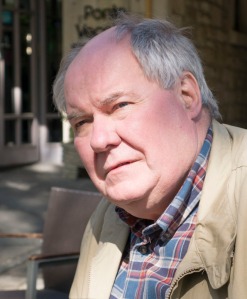Find a location with good light for a portrait shot. Place your subject some distance in front of a simple background and select a wide aperture together with a moderately long focal length such as 100mm on a 35mm full-frame camera (about 65mm on a cropped-frame camera). Take a viewpoint about one and a half metres from your subject, allowing you to compose a headshot comfortably within the frame. Focus on the eyes and take the shot.
 I was probably a bit close to my husband for this exercise. However, it does demonstrate the way the shallow depth of field makes the subject stand out. Taken on a cropped sensor 4/3 Lumix GX7 set on Aperture Priority, 1/320 @ F 5.6, FL 42mm.
I was probably a bit close to my husband for this exercise. However, it does demonstrate the way the shallow depth of field makes the subject stand out. Taken on a cropped sensor 4/3 Lumix GX7 set on Aperture Priority, 1/320 @ F 5.6, FL 42mm.

Given a very helpful comment on my blog regarding the portrait shot of my husband, I wonder if this would be a better option for the exercise. The background may still be a bit cluttered but the lighting is better. Taken with a Canon 5D Mk III using a 24-105mm lens and zoomed at 73 mm. 1/320 @ f4.0.

Lynda
I don’t like to be negative but I thought I would respond to this post because I am not sure you have fully understand the brief.
Firstly, good light in portraiture seldom means direct sunlight if only because the subject is likely to start squinting! Dappled lighting is pleasant and you might have been better off placing your subject in the shade and using a reflector to bounce a softer light onto his face.
A simple background is not a cluttered one. For instance, a wash of green leaves in which their detail is obscured might work.
Using 100mm on a 35mm system suggests a tight crop; 80mm is probably a more standard length. However, there is nothing against using a wide angle close up.
I can not see that you have to be a certain distance from your subject and often you might not have a choice.
This all sounds a bit mean but since your exercise was an attempt to make a formal portrait by implementing certain guidelines, I have responded in similar fashion.
Good Luck with your photography of people! Rome was not built in a day etc etc etc
This book has been recommended to OCA students; Light: Science and Magic … http://www.amazon.co.uk/Light-Science-Magic-Introduction-Photographic-ebook/dp/B00S1DD870/ref=tmm_kin_swatch_0?_encoding=UTF8&qid=1453289044&sr=1-1
available as a Kindle as well as physically
actually there are countless photography portrait books on the market …
LikeLike
Thank you Armano, for taking the time to comment on my exercise. I’m not sure that I entirely agree with you that the exercise was about setting up a formal portrait. I thought it was more about demonstrating how depth of field affected a particular shot. I agree that it’s not the best and there are reasons for that as I lost all the shots I took for these exercises because of computer and back up malfunction, so I am trying to catch up on my blog. I’m also not sure what you meant by using a 100mm on a 35mm and that 80mm is more like standard. I was using a 4/3 crop sensor with a 14-42mm lens and shot it at maximum zoom. I thought this would be equal to 84mm on a full frame. I do appreciate your comments, thank you.
LikeLike